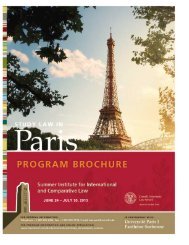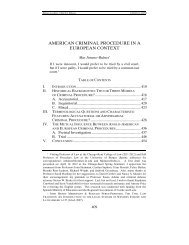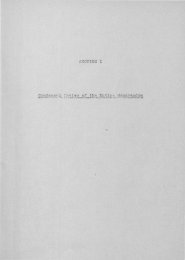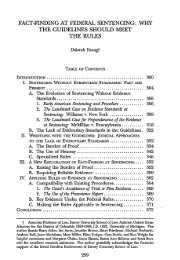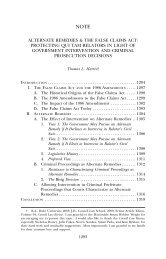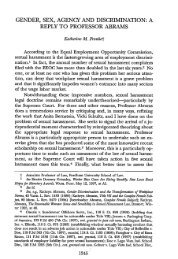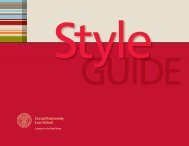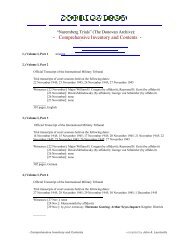JUDICIAL CLERKSHIP HANDBOOK - Cornell University Law School
JUDICIAL CLERKSHIP HANDBOOK - Cornell University Law School
JUDICIAL CLERKSHIP HANDBOOK - Cornell University Law School
You also want an ePaper? Increase the reach of your titles
YUMPU automatically turns print PDFs into web optimized ePapers that Google loves.
Applying to everyone in October sounds simple<br />
enough, but there is a catch — the Justices are<br />
hiring for different Terms during the same season.<br />
For example, Justice Kennedy has been<br />
known to interview in the fall in some years, like<br />
Justice Ginsburg. Justice Kennedy, however, has<br />
been interviewing for the next Term, not two<br />
Terms ahead. Candidates who apply before the<br />
start of their lower court clerkships could face a<br />
dilemma, since they would be unable to accept a<br />
Supreme Court clerkship for the next Term.<br />
Those who apply during or after their lower<br />
court clerkship would face no obstacle from<br />
these vagaries of the hiring schedule. Though I<br />
acknowledge the difficulty, I generally suggest<br />
candidates ignore it because it is too difficult to<br />
predict what a given Justice’s hiring status will<br />
be at any particular point in the year. All candidates<br />
should note their availability in their cover<br />
letters and let the Justices determine whether the<br />
schedules match well.<br />
The application package<br />
After creating an application package for their<br />
first clerkship, candidates find the Supreme<br />
Court package remarkably similar. I usually suggest<br />
sending the application in a manner that<br />
confirms receipt rather than counting on a confirmation<br />
from chambers.<br />
Cover letter. The cover letter offers the Justice<br />
some information about the candidate and the<br />
candidate’s availability. The letter also serves<br />
to identify the other materials in the package,<br />
and to let the Justice know the names of the<br />
people who will be sending recommendation<br />
letters. In most cases, there is no reason for the<br />
cover letter to exceed one page.<br />
Résumé. The résumé should offer a<br />
comprehensive summary of significant<br />
academic accomplishments, a publication<br />
record, and work experience. At this point,<br />
candidates can be less concerned about<br />
limiting the résumé to a single page than about<br />
including all the relevant information. Keep in<br />
mind, however, that “comprehensive” does not<br />
necessarily mean “all-inclusive” — include<br />
significant data, not every event.<br />
Recommenders. Although the names of<br />
recommenders are included in the cover letter,<br />
applicants should also provide complete<br />
contact information. The package can include<br />
a separate sheet listing the full name, full title,<br />
address, and telephone number for each<br />
recommender. As an alternative, they can be<br />
listed at the end of the résumé if there is<br />
sufficient space on the page. Recommendation<br />
letters should be sent directly to the chambers<br />
by the authors. How many recommenders? At<br />
least three. Because many lower court judges<br />
require three recommendations, this can be an<br />
easy requirement to fulfill. Those who apply<br />
during or after a lower court clerkship should<br />
include a recommendation from the judge, if<br />
at all possible, because that judge is in the best<br />
position to evaluate the candidate in the most<br />
directly relevant job setting. The judge’s letter<br />
can substitute for one of the recommendations<br />
used previously, or it can be a fourth<br />
recommendation. If a candidate chooses to<br />
apply at a later point in the career path —<br />
someone finishing a stint in one of the federal<br />
attorney honors programs, for example — it<br />
might make sense to include a letter from that<br />
employer. Bear in mind, however, that more is<br />
not necessarily better. Applicants want enough<br />
letters to highlight their intellectual strengths,<br />
their legal skills, and their additional<br />
talents — but not so many that they appear to<br />
be trying to impress the readers with sheer<br />
volume.<br />
Transcript(s). The package must include the<br />
most current law school transcript. Applicants<br />
with other graduate degrees might consider<br />
including those transcripts as well.<br />
Writing sample. Candidates should send a<br />
sample that best demonstrates their skill with<br />
prose and talent for legal analysis. Those who<br />
have published a note or other law-related<br />
article could consider including a reprint.<br />
Reprinted from NALP Bulletin, October 2002.<br />
© NALP 2002. All rights reserved. This article may be printed for personal use only. Any reproduction, retransmission or<br />
republication of all or part of this material is expressly prohibited unless NALP or the copyright owner has granted prior<br />
written consent. For reprint permission contact the NALP office at (202) 835-1001 or www.nalp.org.<br />
2



